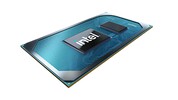Intel Core i5-1145G7 vs AMD Ryzen 5 PRO 5650U vs Intel Core i3-1125G4
Intel Core i5-1145G7
► remove from comparison
The Intel Core i5-1145G7 is a power efficient quad-core SoC for laptops and Ultrabooks based on the Tiger Lake-U generation that was announced early 2021. It integrates four Willow Cove processor cores (8 threads thanks to HyperThreading). The base clock speed depends on the TDP settings and ranges from 1.1 GHz (12 Watt TDP) up to 2.6 GHz (28 Watt). The Boost is always specified at 4.4 GHz (one or two cores).
Another novelty is the integrated Xe graphics card with 80 EUs based on the completely new Gen 12 architecture. It offers a significantly higher performance compared to the older Iris Plus G7 (Ice Lake).
Furthermore, Tiger Lake SoCs add PCIe 4 support (4 lanes), AI hardware acceleration, and the partial integration of Thunderbolt 4 / USB 4 and Wifi 6 in the chip. In addition to this, the i5 supports vPro for easy remote management.
The chip is produced on the improved 10nm SuperFin process at Intel that should be comparable to the 7nm process at TSMC (e.g. Ryzen 4000 series).
All articles on Tiger Lake can be found on our Tiger Lake architecture hub.
AMD Ryzen 5 PRO 5650U
► remove from comparison
The AMD Ryzen 5 PRO 5650U is a processor for thin and light laptops based on the Cezanne generation. The R5 5650U integrates six of the eight cores based on the Zen 3 microarchitecture and is the third fastest U-series processor at launch. The cores are clocked at 2.3 (guaranteed base clock) to 4.2 GHz (Turbo) and support SMT / Hyperthreading (12 threads). The chip is manufactured in the modern 7 nm process at TSMC.
The PRO CPUs offer additional management and security features. The 5650U is otherwise identical to the Ryzen 5 5600U.
The new Zen 3 microarchitecture offers a significantly higher IPC (instructions per clock) compared to Zen 2. For desktop processors AMD claims 19 percent on average and in applications reviews showed around 12% gains at the same clock speed.
With the increased clock speed and IPC improvements thanks to Zen 3, the Ryzen 5 PRO 5650U should be clearly faster than the 200 MHz lower clocked Ryzen 5 4500U.
In addition to the six CPU cores, the APU also integrates a Radeon RX Vega 7 integrated graphics card with 7 CUs and up to 1800 MHz. The dual channel memory controller supports DDR4-3200 and energy efficient LPDDR4-4266 RAM. Furthermore, 12 MB level 3 cache (up from 8 MB at the 4800U) can be found on the chip.
The TDP of the APU is specified at 15 Watt (default) and can be configured from 10 to 25 Watt by the laptop vendor (most chips are configured higher than 15 Watt). That means the chip is intended for thin and light laptops (but with fans).
Intel Core i3-1125G4
► remove from comparison
The Intel Core i3-1125G4 is a 28 W quad-core SoC for laptops and Ultrabooks of the Tiger Lake family (UP3) that was introduced in September 2020. It integrates four Willow Cove processor cores (8 threads thanks to Hyper-Threading). Each core can clock from 2 GHz (guaranteed base speed @ 28 W) to 3.7 GHz (single-core boost). All cores at once can clock at up to 3.3 GHz. The faster Core i7 models offer more Level 3 cache (12 versus 8 MB in the i5) and higher clocked cores.
Another novelty is the integrated Xe GPU based on the completely new Gen 12 architecture. In the i3-1125G4 Intel names the GPU UHD Graphics and offers only 48 of the 96 EUs clocked at 400 - 1250 MHz. The GPU and CPU can together use the 8 MB of L3 cache.
Furthermore, Tiger Lake SoCs add PCIe 4 support (four lanes), AI hardware acceleration, and the partial integration of Thunderbolt 4 / USB 4 and Wi-Fi 6 in the chip.
Performance
While we have not tested a single laptop built around the 1125G4 as of October 2023, we expect the chip's multi-thread performance to be 10% to 20% lower than that of the Core i5-1135G7 (4 cores, 8 threads, somewhat higher clock speeds).
Your mileage may vary depending on how high the CPU power limits are and how competent the cooling solution of your system is.
Power consumption
This Core i3 series chip has a default TDP of 12 W to 28 W, the expectation being that laptop makers will go for a higher value in exchange for higher performance. Either way, that's a little too high to allow for passively cooled designs.
The i3-1125G4 is manufactured on Intel's third-gen 10 nm process marketed as SuperFin for average, as of early 2023, energy efficiency.
| Model | Intel Core i5-1145G7 | AMD Ryzen 5 PRO 5650U | Intel Core i3-1125G4 | ||||||||||||||||||||||||||||||||||||||||||||||||||||||||||||||||||||||||||||
| Codename | Tiger Lake-UP3 | Cezanne-U PRO (Zen 3) | Tiger Lake-UP3 | ||||||||||||||||||||||||||||||||||||||||||||||||||||||||||||||||||||||||||||
| Series | Intel Tiger Lake | AMD Cezanne (Zen 3, Ryzen 5000) | Intel Tiger Lake | ||||||||||||||||||||||||||||||||||||||||||||||||||||||||||||||||||||||||||||
| Series: Tiger Lake Tiger Lake-UP3 |
|
|
| ||||||||||||||||||||||||||||||||||||||||||||||||||||||||||||||||||||||||||||
| Clock | 2600 - 4400 MHz | 2300 - 4200 MHz | 2000 - 3700 MHz | ||||||||||||||||||||||||||||||||||||||||||||||||||||||||||||||||||||||||||||
| L1 Cache | 320 KB | 384 KB | 320 KB | ||||||||||||||||||||||||||||||||||||||||||||||||||||||||||||||||||||||||||||
| L2 Cache | 5 MB | 3 MB | 5 MB | ||||||||||||||||||||||||||||||||||||||||||||||||||||||||||||||||||||||||||||
| L3 Cache | 8 MB | 16 MB | 8 MB | ||||||||||||||||||||||||||||||||||||||||||||||||||||||||||||||||||||||||||||
| Cores / Threads | 4 / 8 | 6 / 12 | 4 / 8 | ||||||||||||||||||||||||||||||||||||||||||||||||||||||||||||||||||||||||||||
| TDP | 28 Watt | 15 Watt | 28 Watt | ||||||||||||||||||||||||||||||||||||||||||||||||||||||||||||||||||||||||||||
| Technology | 10 nm | 7 nm | 10 nm | ||||||||||||||||||||||||||||||||||||||||||||||||||||||||||||||||||||||||||||
| max. Temp. | 100 °C | 105 °C | 100 °C | ||||||||||||||||||||||||||||||||||||||||||||||||||||||||||||||||||||||||||||
| Socket | BGA1449 | FP6 | BGA1449 | ||||||||||||||||||||||||||||||||||||||||||||||||||||||||||||||||||||||||||||
| Features | DDR4-3200/LPDDR4x-4266 RAM, PCIe 4, 4 GT/s bus, DL Boost, GNA, vPro, MMX, SSE, SSE2, SSE3, SSSE3, SSE4.1, SSE4.2, AVX, AVX2, AVX-512, BMI2, ABM, FMA, ADX, VMX, SMX, SMEP, SMAP, EIST, TM1, TM2, HT, Turbo, SST, AES-NI, RDRAND, RDSEED, SHA, TME | DDR4-3200/LPDDR4-4266 RAM, PCIe 3, PRO, MMX, SSE, SSE2, SSE3, SSSE3, SSE4A, SSE4.1, SSE4.2, AVX, AVX2, BMI2, ABM, FMA, ADX, SMEP, SMAP, SMT, CPB, AES-NI, RDRAND, RDSEED, SHA, SME | DDR4-3200/LPDDR4x-3733 RAM, PCIe 4, 4 GT/s bus, DL Boost, GNA, MMX, SSE, SSE2, SSE3, SSSE3, SSE4.1, SSE4.2, AVX, AVX2, AVX-512, BMI2, ABM, FMA, ADX, VMX, SMX, SMEP, SMAP, EIST, TM1, TM2, Hyper-Threading, Turbo, SST, AES-NI, RDRAND, RDSEED, SHA, TME | ||||||||||||||||||||||||||||||||||||||||||||||||||||||||||||||||||||||||||||
| iGPU | Intel Iris Xe Graphics G7 80EUs (400 - 1300 MHz) | AMD Radeon RX Vega 7 ( - 1800 MHz) | Intel UHD Graphics Xe G4 48EUs (400 - 1250 MHz) | ||||||||||||||||||||||||||||||||||||||||||||||||||||||||||||||||||||||||||||
| Architecture | x86 | x86 | x86 | ||||||||||||||||||||||||||||||||||||||||||||||||||||||||||||||||||||||||||||
| Announced | |||||||||||||||||||||||||||||||||||||||||||||||||||||||||||||||||||||||||||||||
| Manufacturer | ark.intel.com | www.amd.com | ark.intel.com |
Benchmarks
Average Benchmarks Intel Core i5-1145G7 → 100% n=2
Average Benchmarks AMD Ryzen 5 PRO 5650U → 102% n=2
Average Benchmarks Intel Core i3-1125G4 → 77% n=2
* Smaller numbers mean a higher performance
1 This benchmark is not used for the average calculation













